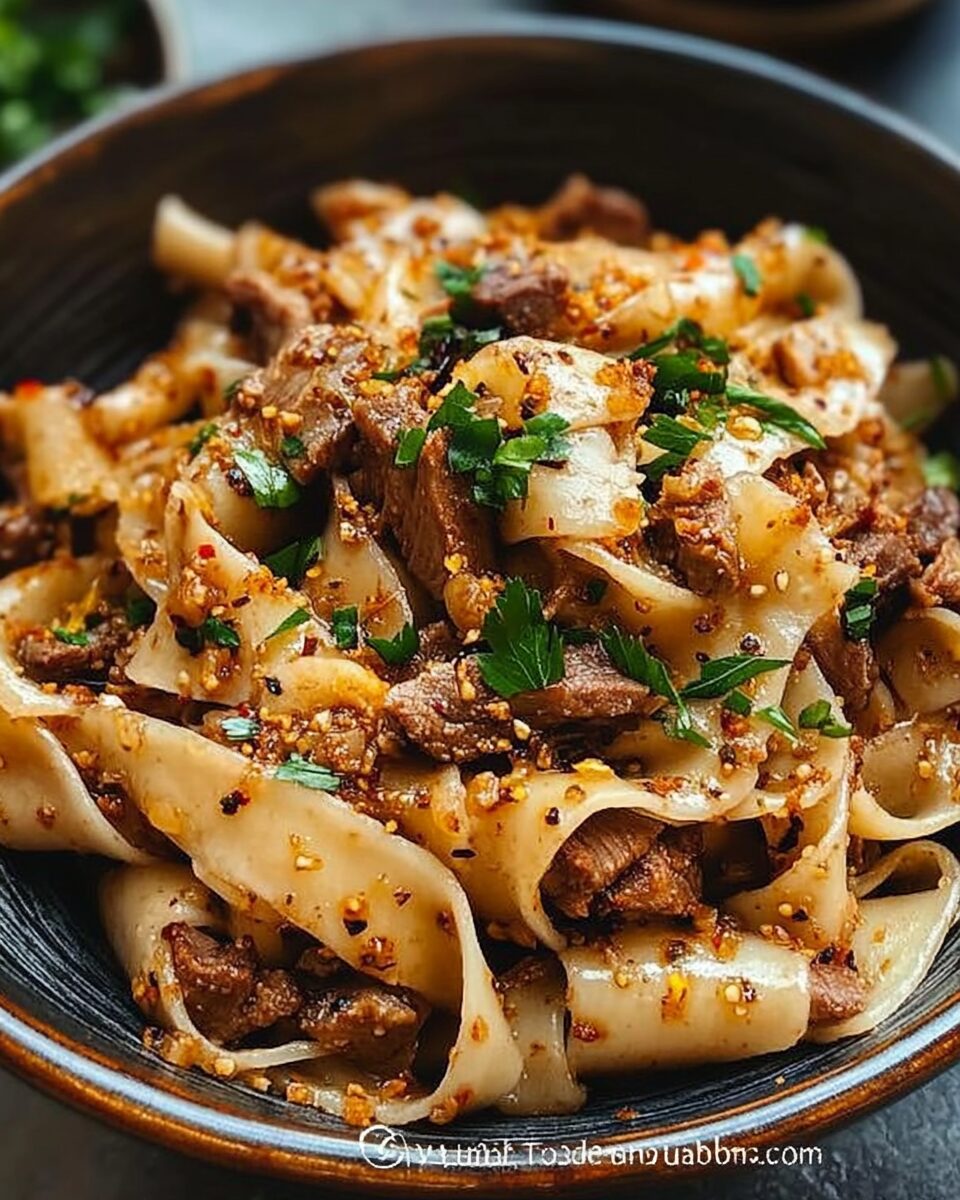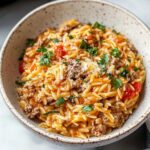The fiery kick of these cumin lamb noodles brings the heat straight from Xi’an’s iconic street stalls. Tossed in aromatic chili oil and balanced with fresh herbs, this dish is a masterpiece of bold spices, tender lamb, and chewy hand pulled noodles.
Whether you’re exploring Sichuan peppercorns for the first time or just craving deep umami with a touch of heat, this recipe will transport you to northern China in one unforgettable bite. Pair it with a cool cucumber salad and a crisp lager for the perfect homemade noodle night.
Full Recipes:
Ingredients:
Noodles:
-
1 batch homemade hand-pulled noodles (or substitute wide wheat noodles)
Spice Mix:
-
2 tablespoons whole cumin seeds
-
2 teaspoons Sichuan peppercorns
-
1 teaspoon whole coriander seeds
Meat & Marinade:
-
1 lb lamb (shoulder or loin), thinly sliced against the grain
-
1 tablespoon Shaoxing wine (or dry sherry)
-
1 teaspoon salt
-
1 teaspoon peanut oil (or vegetable oil)
-
2 teaspoons cornstarch
Sauce:
-
1/2 cup homemade chili oil (or 1/4 cup for a milder version)
-
3 tablespoons Chinkiang vinegar
-
1/4 cup Shaoxing wine (or dry sherry)
-
4 teaspoons light soy sauce
-
4 teaspoons dark soy sauce
Stir Fry:
-
1 tablespoon peanut oil (or vegetable oil)
-
8 cloves garlic, minced
-
2 inches ginger, minced
-
1 red onion, thinly sliced
-
1 hot green chili, sliced
-
1/2 bunch cilantro, chopped (1 heaping cup loosely packed)
Directions:
-
Toast cumin, Sichuan peppercorns, and coriander seeds in a dry pan over medium-low heat for 5 minutes until fragrant. Grind to a coarse powder.
-
In a bowl, combine lamb slices with Shaoxing wine, salt, oil, and 2 teaspoons of the spice mix. Mix well, then add cornstarch and coat the meat evenly. Marinate for 15 minutes.
-
Heat oil in a large skillet over high heat until smoking. Add marinated lamb in a single layer and sear for 30 seconds until browned on one side.
-
Add garlic and ginger, stir until fragrant and lamb is almost fully cooked.
-
Toss in red onion and green chili. Stir fry for 10–20 seconds.
-
Sprinkle the remaining spice mix and toss to coat.
-
Pour in sauce mixture and stir quickly to deglaze the pan.
-
Turn off heat, add cilantro, and toss to combine. Transfer to a plate.
-
Boil hand-pulled noodles or cook packaged noodles as per instructions.
-
Place noodles in bowls, top with lamb and sauce, and drizzle extra chili oil or soy sauce if desired.
Prep Time: 25 minutes | Cooking Time: 5 minutes | Total Time: 30 minutes
Kcal: 531 kcal | Servings: 4 servings
Cumin Lamb Noodles: A Bold Journey of Flavor from Xi’an to Your Kitchen
In the heart of northwestern China, where culinary influences from Central Asia meet the bold spices of the Chinese interior, one dish has risen from humble origins to gain global acclaim: cumin lamb noodles. A signature street food from the city of Xi’an home of the Terracotta Army and a crossroads of the ancient Silk Road this noodle dish represents a glorious fusion of spice, heat, texture, and cultural depth.
If you’ve ever had the privilege of wandering through the alleyways of Xi’an’s Muslim Quarter, the aroma of sizzling cumin, the crackle of hot oil, and the rhythmic slapping of hand-pulled noodles against countertops is unforgettable. But thanks to recipes like the one from Omnivore’s Cookbook, you can now bring that same experience into your home kitchen, complete with fiery chili oil, fragrant lamb, and chewy noodles.
A Taste of Xi’an: Cultural Origins
Xi’an’s food reflects its long history as a cultural melting pot. With significant Islamic influence from the Hui people and a climate suited for hearty wheat-based dishes, the region developed a unique culinary identity that stands apart from the more familiar flavors of southern Chinese cuisine.
Cumin, not traditionally a core spice in most Chinese food, is abundant here likely brought by merchants and travelers from Persia and the Middle East centuries ago. Lamb, too, is a protein more common in Islamic and Mongolian culinary traditions. When these flavors were blended with Chinese stir-frying techniques and handmade wheat noodles, the result was this unforgettable dish.
Cumin lamb noodles are not just food they’re an embodiment of cultural history and trade, of resilience and adaptability. They are as much about storytelling as they are about sustenance.
What Makes This Dish Stand Out?
At a glance, cumin lamb noodles might look like a typical stir-fry noodle dish. But once you take that first bite, the difference is unmistakable. Bold, unapologetic, and spicy, this dish is all about layers of flavor.
The lamb is marinated and seared to perfection, locking in juices while absorbing a fragrant blend of toasted spices. The cumin seeds ideally toasted and freshly ground impart a smoky, earthy undertone, while Sichuan peppercorns bring that signature tongue tingling numbing sensation. Garlic and ginger add pungency and heat, while thin slices of onion and chili peppers provide sweetness and fire. The pièce de résistance is the chili oil typically homemade, mellow yet fiery, packed with complexity.
All of this is brought together with hand-pulled noodles (or wide wheat noodles as a quicker substitute). The noodles themselves aren’t just a vehicle for the sauce they are part of the flavor experience, absorbing the savory, spicy sauce while offering a satisfying chew.
Cooking Techniques: Stir-Fry Meets Tradition
What’s particularly fascinating about this recipe is how it bridges traditional techniques with the convenience of modern cooking. It’s a textbook stir-fry, but the preparation leans into slow, intentional steps: dry-toasting whole spices, carefully slicing and marinating lamb, pre-prepping all aromatics before heat ever touches the pan. This is not a dish to cook on autopilot.
Cooking begins with dry-roasting the whole cumin seeds, Sichuan peppercorns, and coriander seeds. This technique enhances their aromatic oils, offering a deeper flavor than their pre-ground counterparts. The spices are then freshly ground sometimes with a mortar and pestle, or with a spice grinder to unlock their full complexity.
The lamb is thinly sliced and marinated, allowing the cornstarch to tenderize it while the wine and oil begin infusing the meat. The actual stir-fry process is lightning fast just a few minutes of high-heat cooking meaning you must have all components ready to go beforehand. This is often referred to in Chinese cooking as “mise en place on steroids.”
As the lamb hits the searing hot oil, it caramelizes and releases its aroma. In seconds, ginger and garlic follow. Chili oil and soy sauces are then added, creating a spicy sweet glaze that clings to the meat and aromatics. Finally, the dish is tossed with fresh cilantro and served over hot, chewy noodles.
A Dish That Welcomes Creativity
One of the greatest things about cumin lamb noodles is their versatility. While the traditional version calls for hand-pulled noodles and fatty cuts of lamb, home cooks can adapt the recipe to suit what they have. Don’t want to hand-pull your own dough? Use store bought wide wheat noodles or even fresh linguine as a stand-in. Can’t find lamb shoulder? Use ground lamb, thin-cut beef, or even portobello mushrooms for a plant-based version.
The recipe also invites customization in spice levels. Some might prefer to dial back the chili oil or omit the fresh chilies for a milder version. Others may double the cumin or throw in some toasted fennel seeds for added complexity.
There’s even room to expand the dish with vegetables like sautéed eggplant, snap peas, or bok choy though purists may argue that the minimalist composition is what makes this dish shine.
Why It’s Worth the Effort
This isn’t your average 30-minute weeknight dinner. While you can make a quicker version with shortcuts, the true magic of cumin lamb noodles lies in the details. It’s a weekend project, a labor of love, and one that pays off with every bite.
What makes the extra effort worthwhile is not just the flavor, but the sense of accomplishment and authenticity that comes from recreating a dish deeply tied to regional identity and cultural pride. When the spices hit the pan and your kitchen fills with the scent of chili, cumin, and caramelized onion, you’re transported to the bustling food stalls of Xi’an no passport required.
From Street Food to Home Favorite
Cumin lamb noodles have enjoyed a surge of popularity in recent years thanks in part to restaurants like Xi’an Famous Foods in New York City and the increasing accessibility of Chinese pantry ingredients online. The dish has become something of a cult classic among adventurous eaters and home cooks looking to level up their skills.
Recipes like the one from Maggie Zhu on Omnivore’s Cookbook make these bold dishes accessible, stripping away the intimidation factor without compromising on flavor. Her detailed approach, helpful substitutions, and cultural insights make this dish approachable even for those new to Chinese cooking.
For food bloggers, content creators, or chefs building their home recipe libraries, this dish offers a visually striking, flavor-packed anchor recipe perfect for showing off plating skills, cultural depth, and a willingness to go beyond takeout style fare.
Conclusion:
Cumin lamb noodles are more than just a noodle bowl. They are a culinary bridge between East and West, tradition and innovation, street food and fine dining. With every spicy, aromatic bite, you taste centuries of trade, fusion, and creativity.
While the recipe might seem complex, it is also one of the most rewarding noodle dishes a home cook can master. Whether you’re recreating a favorite meal from a trip to Xi’an, impressing dinner guests, or simply exploring bold new flavors, this dish delivers satisfaction on every level.
So next time you’re craving something different, something exciting, and something rooted in history look no further than cumin lamb noodles. It’s not just a meal; it’s a journey.






